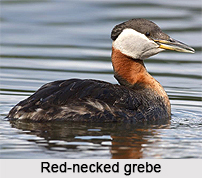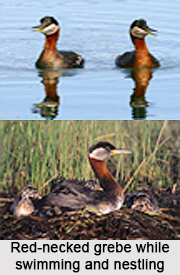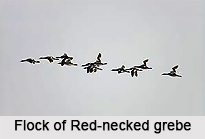 Red-Necked Grebe is an Indian Bird with a scientific name `Podiceps grisegena" is a migratory aquatic bird of India.
Red-Necked Grebe is an Indian Bird with a scientific name `Podiceps grisegena" is a migratory aquatic bird of India.
Naming of Red-Necked Grebe
Red-Necked Grebe has the genus name Podiceps that comes from Latin podicis, "vent" or "anus", and pes, "foot", and is a reference to the placement of a grebe`s legs towards the rear of its body. The species name Grisegena is from Latin griseus (grey) and gena (cheek) and refers to the face pattern of the breeding adult.
Concentration of Red-Necked Grebe
Red-necked grebe found in the temperate regions of the northern hemisphere. Its wintering habitat is largely restricted to calm waters just beyond the waves around ocean coasts, although some birds may winter on large lakes. Red-necked grebe prefers shallow bodies of fresh water such as lakes, marshes or fish-ponds as breeding sites.
Breeding Season of Red-Necked Grebe
Red-necked grebe is a nondescript dusky-grey bird in winter. During the breeding season, it acquires the distinctive red neck plumage, black cap and contrasting pale grey face from which its name was derived. It also has an elaborate courtship display and a variety of loud mating calls. Once paired, it builds a nest from water plants on top of floating vegetation in a shallow lake or bog.
Behaviour of Red-Necked Grebe
Red-necked is a swimmer bird. It is particularly swift diver, and responds to danger by diving rather than flying. The feet are positioned far back on the body, near the tail, which makes the bird ungainly on land. It dives for fish or picks insects off vegetation; it also swallows its own feathers, possibly to protect the digestive system.
Conservation of Red-Necked Grebe
The conservation status of Red-Necked Grebe is on its two subspecies- Grisegena found in Europe and western Asia, and the larger Holboelii in North America and eastern Siberia is evaluated as Least Concern, and the global population is stable or growing.
Structure of Red-Necked Grebe
Red-Necked Grebes are small to medium-large water birds with lobed, rather than webbed, toes. There are several genera, of which the most widespread is Podiceps with nine species, one recently extinct. Red-necked grebes` closest relative is the fish-eating great crested grebe of Europe and western Asia. The red-necked grebe is a medium-large grebe, smaller than the great crested grebe of Eurasia, and the western and Clark`s grebes of North America.
Size of Red-Necked Grebes
The adult of Red-necked grebes has the nominate European subspecies is 40-50 cm long with a 77-85 centimetres average wingspan, and weighs 692-925 grams. In breeding plumage, it has a black cap that extends below the eye, very pale grey cheeks and throat, a rusty red neck, dark grey back and flanks, and white underparts. The eyes are dark brown and the long, pointed bill is black with a yellow base.
Migration of Red-Necked Grebe
Red-necked grebe originally evolved in North America and later spread to Europe, where a change of diet to include more insects helped to reduce competition with its larger cousin. Fossils of the species dating to the middle Pleistocene have been found in Italy.
Sexes of Red-Necked Grebes
The sexes of Red-necked grebes are similar in appearance, although the male averages heavier than the female. Chicks have a striped head and breast, and older juveniles have a striped face, diffuse blackish cap, pale red neck and extensive yellow on the bill.
Flying Mode of Red-Necked Grebes
 Red-necked grebes fly with its long neck extended and its large feet trailing behind the body, which gives it a stretched-out appearance. The relatively small wings are grey with white secondaries, and beat very rapidly. Its small wing area means that the grebe is unable to take off from land, and needs a lengthy run across water to gain the speed needed for take-off. Like all grebes, the red-necked is an expert swimmer; it uses its feet for propulsion underwater, and steers by rotating its legs, since its tail is too short for this purpose.
Red-necked grebes fly with its long neck extended and its large feet trailing behind the body, which gives it a stretched-out appearance. The relatively small wings are grey with white secondaries, and beat very rapidly. Its small wing area means that the grebe is unable to take off from land, and needs a lengthy run across water to gain the speed needed for take-off. Like all grebes, the red-necked is an expert swimmer; it uses its feet for propulsion underwater, and steers by rotating its legs, since its tail is too short for this purpose.
Breeding of Red-Necked Grebes
Breeding takes place in shallow freshwater lakes, bays of larger lakes, marshes, and other inland bodies of water, often less than 7.4 acres in extent and less than 2 m (6.6 ft) deep. The red-necked grebe shows a preference for water in forested areas or, further north, in shrub tundra, and favours sites with abundant emergent vegetation, such as reedbeds. The best breeding habitat is fish-ponds, which have an abundance of food in addition to meeting the other requirements. The migration is usually at night, but may occur during the day, especially when over water. This is particularly noticeable in autumn on the Great Lakes, when up to 18,000 birds may pass Whitefish Point on Lake Superior; these are thought to be Canadian breeders heading for the Atlantic Ocean to winter. This easterly route is longer than that to the Pacific, but avoids Rockies.
Population of Red-Necked Grebes
The populations of Red-necked grebes are migratory and winter mainly at sea, usually in estuaries and bays, but often well offshore where fishes are within diving reach near shallow banks or islands. The preferred passage and wintering habitat is water less than 15 m (49 ft) deep with a sand or gravel bottom, scattered rocks and patches of seaweed. During winter, birds typically feed alone and rarely aggregate into flocks, but on migration, concentrations of over 2000 individuals may occur at favoured staging sites.



















